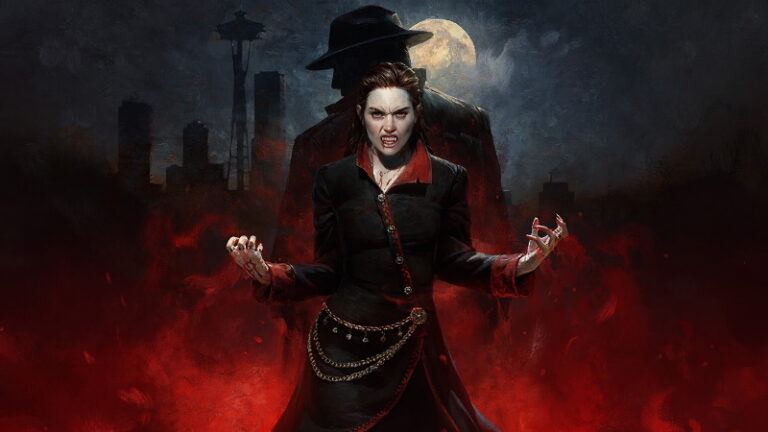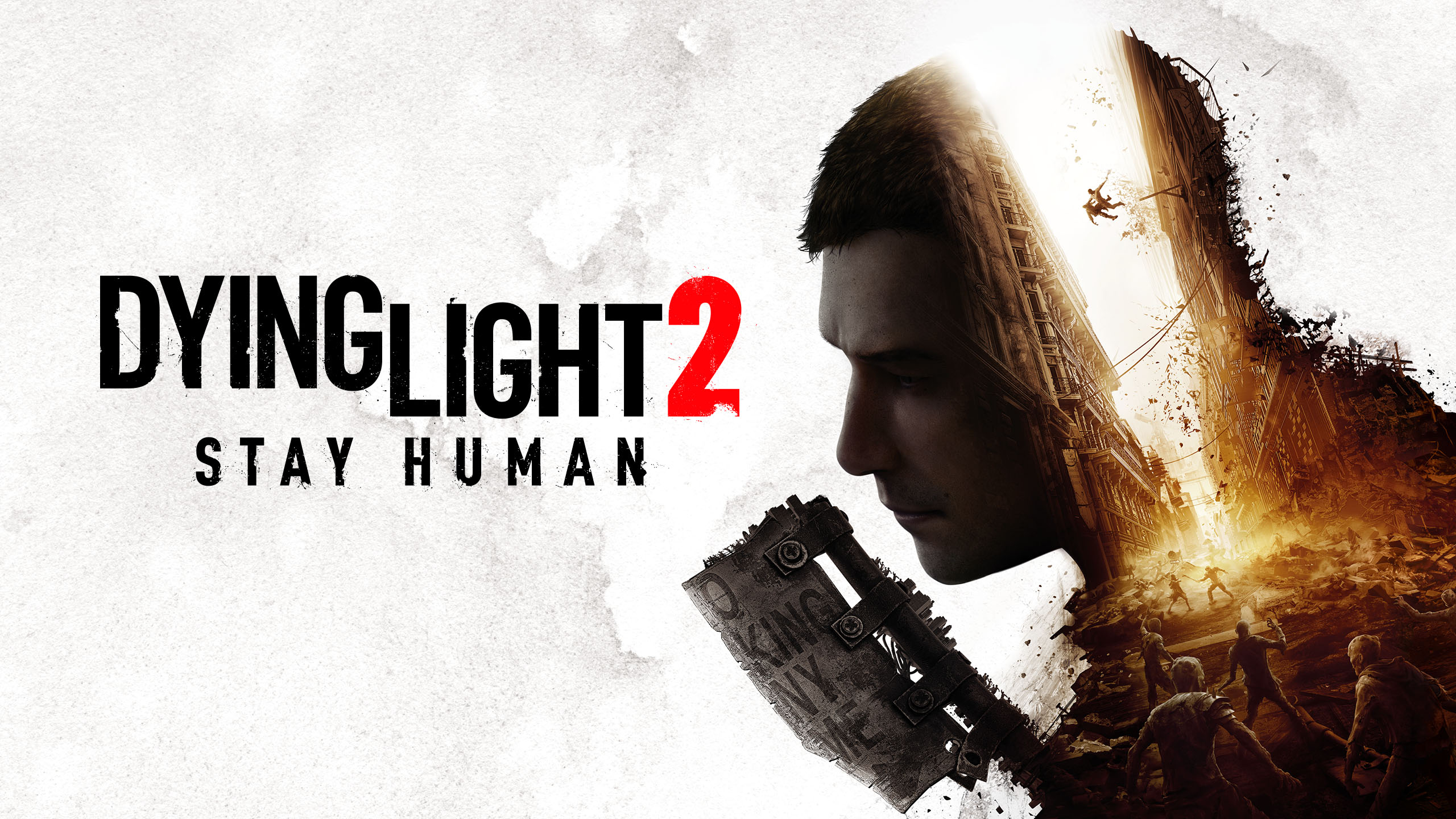
It’s been around three years since Dying Light 2: Stay Human was announced at E3 2018, and in that time we’ve seen it go through quite a tumultuous dev cycle including being ‘delayed indefinitely’ at one point in time. Now, surrounded by tons of hype, high promises, and a treasure trove of new possibilities surrounding it, the game is finally releasing. Was it all worth the wait? Well, as much as the story really should have a happy ending, I’m sorry to say — it’s a very mixed bag.
I’m a pretty huge fan of the first Dying Light, having sunk multiple playthroughs into both the main campaign and its expansion campaign, The Following, over the years. It’s an excellent mix of horror, fun, and a sort of campy silliness that, while not perfect, was an excellent start for a new zombie-slaying franchise. As such I was more than ready to sink my teeth into the world of Dying Light 2: Stay Human, and immediately relished the return to its sleek parkour platforming and tight melee combat. The opening hour or so does an excellent job of bringing you back into this world, which has fallen into post-apocalyptic ruin since the events of the original game. Once we leave this opening act, however, things start to fall apart quickly.
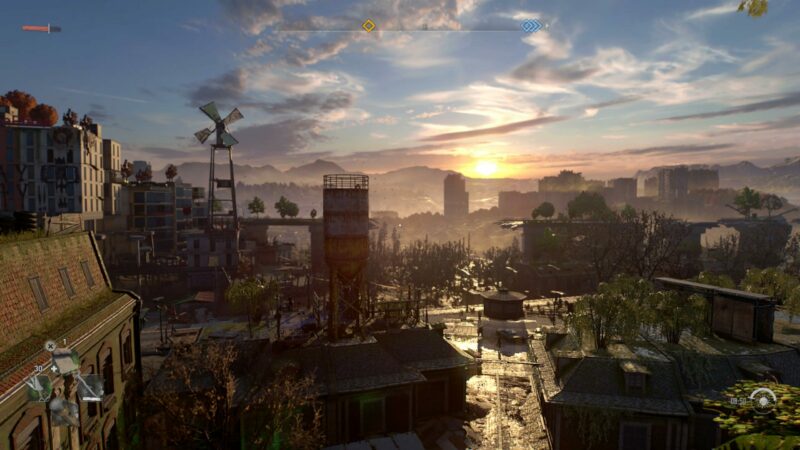
We play as Aiden Caldwell, a “pilgrim” (a sort of post-apocalyptic courier that travels between settlements), who has broken away from that way of life in order to find his sister, Mia, who he lost contact with as a child when the outbreak first began. Aiden’s quest brings him to the new city of Villedor, a massive and sprawling network of safe zones and infested areas alike. However, he quickly finds that maneuvering his way through won’t be as easy as walking up and asking for directions, as he’s thrust into a political battle against warring factions struggling to gain control over the city. The two main sides of this conflict, the survivors (disorganized pockets of ordinary citizens struggling to get by) and the militaristic Peacekeepers (an authoritarian organization that seeks to keep order under their rule) are both able to offer Aiden their help — but only on their terms which mostly involves fighting against the other faction. There also exists the Renegades, but it’s quite a while before Aiden truly runs into them.
This conflict has been at the heart of much of Dying Light 2’s marketing, as your choices can help reshape the world around you. Each faction offers map-changing benefits for siding with them, district to district, and it’s up to you to pick and choose which faction to side with that best suits your interests and playstyle — while also keeping in mind that the farther you tip the scale towards one side, the other side of the conflict will become more and more your enemy. While on paper this might sound similar to other political conflict-oriented games, like Fallout: New Vegas, it’s the much-touted structure system that really makes this stand head and shoulders above any other Western RPG I’ve played.
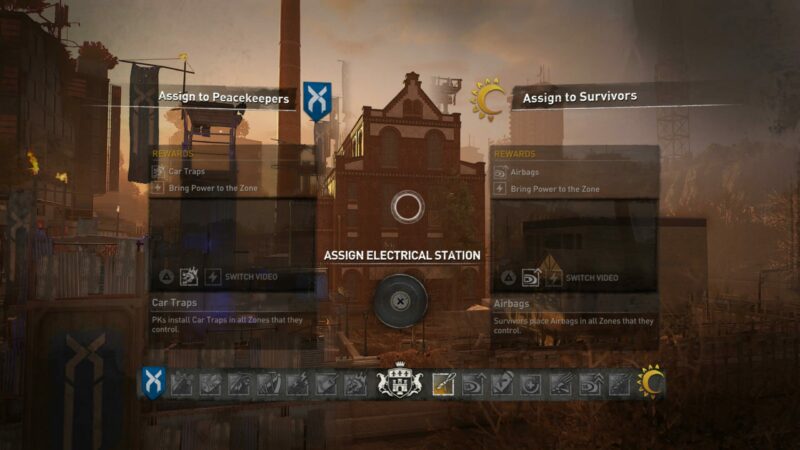
For instance, an early decision tasks the player with making a choice between allowing the Peacekeepers to retain control over a water tower or letting the survivors take it back for themselves. While the peacekeepers are able to offer a greater amount of defense and overall make the district safer should you lock this in as their turf, the survivors will more than happily set up additional ziplines and parkour equipment throughout the district, making traversal easier (and more fun). This decision has immediate and obvious effects on the map itself, and it’s a real marvel to see the world truly change around you and offer new possibilities. Of course, making your choice is final, and will completely tip the scale of power in that area, so you must make your decisions wisely.
While gameplay-altering decisions are Dying Light 2’s major innovation, the developers have also refined the mechanics of the original game, tightening and expanding on both combat and parkour. Combat, for starters, has been upgraded significantly for fighting human enemies, feeling much more in line with the beloved melee encounters from the Condemned series. Bouncing back and forth between finding an opening in an enemy’s defense, blocking incoming attacks, and nailing gory counter-attacks after a well-executed stagger, human combat is diverse and challenging. Even when you’ve gotten some upgrades, such as the ability to hop over stunned enemies in order to deliver a powerful dropkick on the next (thus stunning them and opening them up to a follow-up hop and kick), enemies are smart and genuinely crafty, especially when you’re up against multiple combatants.
It’s difficult to tell which member of the group is going to deliver the next swing at you, some have varying levels of speed that makes getting blocks hard to gauge, and they’ll even psyche you out from time to time in order to open you up for one of their buddies to get a hit in. I genuinely love it, and can’t wait to level up further so I can break out even more complex maneuvers against my enemies. All that said, combat against the living dead is sadly more or less the same as it was in the first game, sans the “Duke’s Mighty Foot” kick attack (which has been replaced by the block). They’re honestly super boring to fight in comparison, and the only real reason to do so is that the story either requires it or you need something they’re all huddled around.
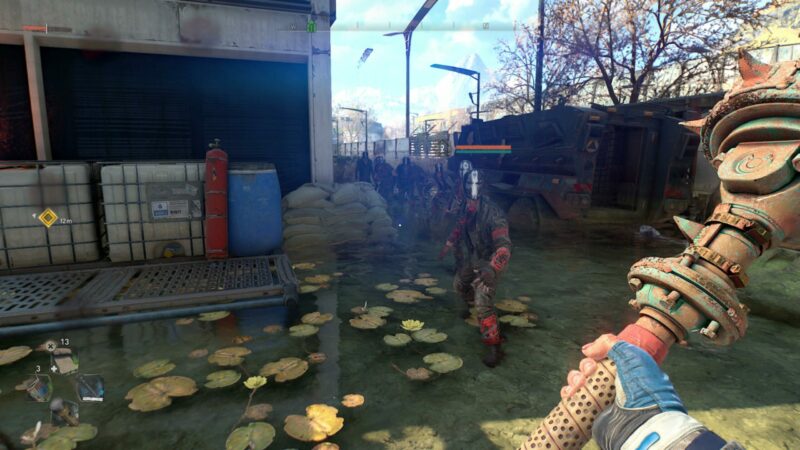
Parkour has also seen some fun upgrades, largely due to the more diverse cityscape you’re able to run and jump through. A new series of open windows and half-constructed barricades offer you much more diverse pathways to leap through, rather than simply racing across rooftops. Leaping from one building’s balcony directly into the window of another, racing through the open apartment, and flinging yourself out the adjacent window and onto the roof of the building beyond is exhilarating and makes the world feel so much more alive and interactive than the first Dying Light. New slanted rooves offer up new challenges, as racing up an incline becomes a struggle, and making your way down one can become a treacherous slide-off if you’re not careful. New cranes and precarious platforms change up your pathfinding with balancing acts, and occasionally things may even begin to collapse under your weight, causing you to need to find an escape route fast. It’s all just amazingly fun and diverse. This isn’t even going into some of the crazier things we get later on, like paragliding to gain access to even taller buildings.
You can expand your abilities by leveling up of course, but this is where the first part of my problems starts to leak in. While you gain points that you can sink into either your combat or parkour skill trees, they are strangely gated off behind the game’s other major “innovation”, namely the fact that your character is infected. From the game’s outset, Aiden has become infected with a new strain of the zombie virus, and while he was saved by an inhibitor shot and will ‘stay human’ under sun or UV light, he requires additional inhibitor shots in order to fully recuperate and can only stay in darkness for so long before the virus begins to mutate (essentially putting a timer on how long you can be out at night, which is annoying in its own right). Additional shots can be found hidden throughout the world, which is used to upgrade either your stamina or your health (and automatically your “resistance” to the darkness regardless of choice), however, the amount of health and stamina you have directly affects the number of skill points you can spend.
For instance, if you have only leveled up your stamina to level 2, you’ll be unable to level up your skill tree beyond level 2 skills. Now at first, you’re probably saying “Well, that isn’t so bad”, but due to requiring three of these shots to level up your stamina one level (and most of the shots only come in sets of two when found), you might find yourself stacking up skill points without being capable of spending them after a certain point. Getting locked into a story mission where you may or may not run into one of the special containers that hold these shots and seeing the notification that you have a new skill point to spend, but be unable to do anything about it, is incredibly frustrating. The obvious answer is to explore more, but that doesn’t make this weird two-step leveling system any less obnoxious.
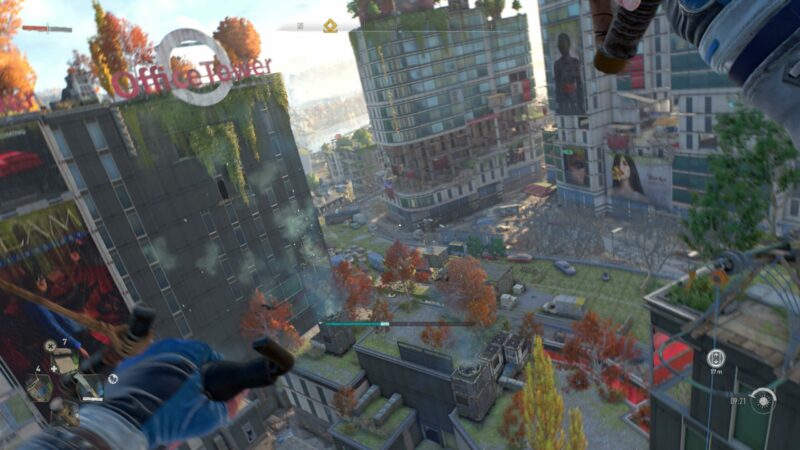
This sort of “two-step” system manifests itself in the game in a number of frustrating ways, constantly perking its head up at the least convenient moments. An example is the game’s health kits, which perplexing come in multiple, but visually identical, varieties. You equip your health kits to an item slot on your item wheel and use them from there. Easy, got it, cool. But, because there are multiple kinds of these health kits, you may discover that when you thought you had five kits equipped, you actually only had two and the other three are buried in your pause screen inventory. Sure, easy to just pause and assign the other kits to the slot when you run out of the other kind in the middle of combat and have to muddle around in menus it’s incredibly frustrating and obnoxious.
Speaking of frustrating and obnoxious, it’s time to talk about the biggest problem with this game, the story. While the first Dying Light’s story wasn’t anything remarkable (save for the incredible ending to The Following), Dying Light 2’s story is frankly unbelievably terrible. It is very easily the worst narrative, and worst told narrative, I have ever had the displeasure of encountering in a game in over ten years as a games journalist. From the characters (who are all horrible assholes who range from snide jerks to annoying morons) to the player character (a generic box art protagonist who sounded so similar to the first game’s Roger Craig Smith I thought they were the same until I looked it up) to the actual events (a frustrating mess of inconsistent motivations and constantly shifting goalposts) I actually had to stop playing for a bit at one point because I was becoming so annoyed with it.
There was never a moment where I wasn’t infuriated with the way the story was told, from an early game event where we find someone being beaten and interrogated for the location of an item they stole (which turned out to literally just be in their pocket and the people beating him didn’t bother to check) to the massive amount of wheel-spinning busywork we’re forced to do… made even more galling when a character casually mentions that there was a secret path they neglected to tell us about before because “they had their own problems” — that we were helping them with. There is no story beat here that doesn’t feel deliberately calculated to make you say either “Huh!?” or “Oh, screw you.”
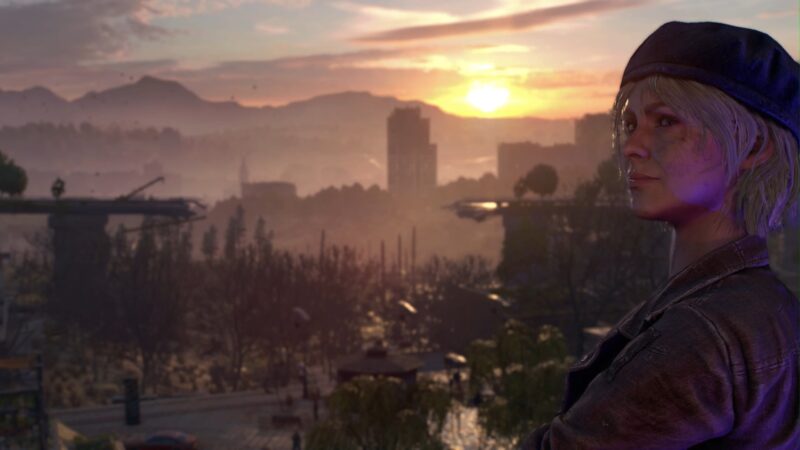
The way the story is told and presented is also shockingly poor for such a giant project. Characters (including the protagonist) often seem to simply forget essential information that we worked hard to discover, or something will happen for an obvious reason but everyone acts shocked like they couldn’t have seen it coming from a million miles away. There’s also a bizarre disconnect (that I can only assume is due to the game trying to juggle so many plot decisions) between interactions that often lead to a kind of story whiplash I genuinely don’t think I’ve ever experienced before. In one scene, we spend a few minutes chatting with the leader of the survivor group, Sophie. When we’re finished (and still locked into the dialogue cutscene camera, no fade-out in between), we turn and speak to Sophie’s brother — and ask him where Sophie is. All in one cutscene. It’s so bizarre, and it left my jaw on the floor as the cutscene continued to play out as if an entire day had passed between me looking to my right, and looking to my left.
Along with this, Dying Light 2 also occasionally gives up on giving us actual choices, such as a crucial moment when we discover very damning evidence against one of the faction’s wrongdoing, and announce to their leader that we’re going to turn them over to the other faction. The evidence in question is irrefutable, and I was absolutely poised to make the choice to side completely with the opposing faction… and it just didn’t offer me the choice. Instead, the character I was speaking with assured me, unprompted, that they actually didn’t do that thing I found evidence of, and I found myself simply being on their side of the conflict for the next several hours of gameplay. I was never offered a choice to follow through with the results of my investigation and instead found myself tasked without recourse to blow up vital bases operated by the other faction and help gather equipment and weapons. I was shocked at how disinterested Dying Light 2 seemed to be with what was very obviously a huge turning point in the conflict, and instead locked me into helping one side without ever even asking. What’s the point of hyping up the choice-based role-playing in this game when such a pivotal moment was just ignored?
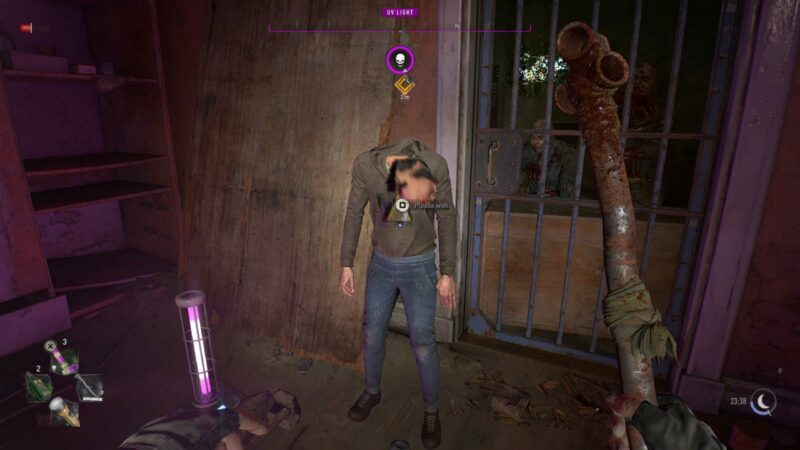
In addition to all the aforementioned problems, Dying Light 2 is also very, very buggy. From a quest NPC’s head spinning around in circles (causing them to be unclickable, and the side-quest impossible to turn in) to the game’s very necessary Survivor Sense simply not functioning, to a hard fall causing my camera to go vaguely third-person revealing Aiden’s headless body running around until I jumped again, I had some sort of issue every time I began playing. There’s also a number of strange visual bugs, the most prominent of which is a strange (but persistent) frame of black every now and again. At first, I thought it might be some sort of blinking effect, but as it still happened on the pause screen, I can only surmise that it’s some sort of visual glitch. The game also has a shocking amount of screen-tearing for a modern game (I played on PS5 where this issue feels even less forgivable).
Yes, I have been playing a pre-release copy of the game, and all these issues may be sorted out with a day one patch — but if not there’s a very good chance we’ll be seeing the same sort of meme bug compilations we always seem to get from these big AAA open-world releases.
At the end of the day, I cannot recommend Dying Light 2, at least not at full price. While the game does feature a lot of extremely fun gameplay and one very cool idea, it’s hampered by too many weird problems (especially when you consider that one very cool idea is directly tied to this terrible, frustrating story) to be enjoyable all the way around. If you’re willing to wait a few months for the game to lower in price or go on sale and go in purely for the gameplay itself (with maybe a podcast on, or at least the voices turned off to listen to the game’s admittedly excellent score standalone), you might have a pretty good time. As a whole though, I have a strong suspicion this may be seen as one of the year’s first big disappointments.
 (4.5 / 10)
(4.5 / 10)
Below Average
 (4.5 / 10)
(4.5 / 10)Rely on Horror Review Score Guide
PlayStation 5 review code provided by the publisher


